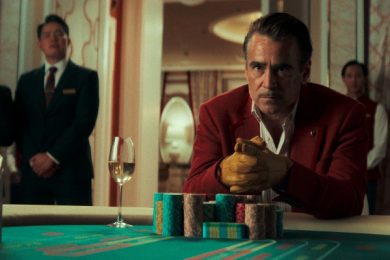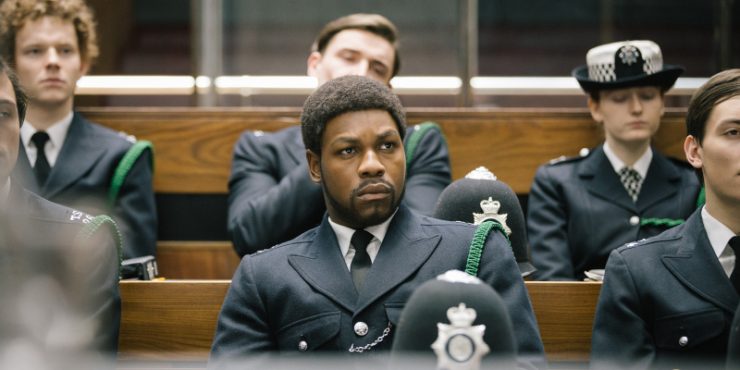Triumphs don’t come without great struggle in the worlds of Steve McQueen. His first three Small Axe films have been about spirited resistance in one way or another, but he flatly refuses to coat it in any romanticism. Even Lovers Rock, the raucous, loosely-plotted dance hall film, was riddled with sobering reminders of the reality outside of the film’s utopia. Red, White and Blue is much more straightforward. You might even call it a “biopic”. McQueen taps Star Wars star John Boyega to play Leroy Logan, a real-life police officer of the London Metropolitan Police. A first-generation Jamaican immigrant, Logan would go on create the Black Police Association. Red, White and Blue doesn’t get quite that far, but instead focuses on his intense entry into the police unit, one that did not go smoothly.
A young Logan is formed early by his father, Ken (Steve Toussaint), a militant Jamaican man whose hostility towards the police needs little tempting when he feels anything even close to harassment. When two constables calmly but firmly ask the grade school-aged Leroy (played by Nathan Vidal) if they can search his belongings, it enrages Ken, who can’t imagine the need to search a child. Decades later, Ken is beaten severely by two constables when he contests a parking ticket. Leroy, at that point a forensics scientist with a PhD, makes a startling decision: he wants to join the metro police and begin work on shifting the institution’s racial biases. Leroy’s quest seems naive to most, and the decision further divides father and son. Demanding a court date against his uniformed attackers, Ken can hardly fathom his own son becoming the enemy.
At the academy, Leroy quickly proves to be the best cadet, both physically and intellectually. He introduces himself in a class full of recruits as someone who hopes to change the culture of policing, and the academy quickly bounces on the chance to use Leroy as a recruitment tool in advertisements. This quickly catches the attention (and resentment) of his white peers, who miss few opportunities to try and knock him down a peg. Even his superior officer (Neil Maskell), does very little to hide his displeasure with having a black constable on his squad. Added to all that, Leroy also gets the ire of his father and the blacks in his community, who view him as a traitor. Leroy’s intentions are noble, and his will is unbreakable, but he learns quickly that he will get nothing in the way of sympathy or compassion in his current position.
Like Mangrove, Red, White and Blue takes a hard look at the inherent racism within London’s policing. Taking place in the 1980’s, McQueen never takes the chance – like many films do – to infer that this is a problem in our past. The intimacy of his filmmaking very much places this period piece into a very real present. Logan’s level of respectability, his appeals to all the principles that the police are supposed to stand for, catches him no relief in the eyes of his white peers, who instead see him as a challenge to their caste structure. He meets all the criteria for what whites demand from a black man, and yet, they still refuse to treat him as an equal.
It’s remarkable how little Red, White and Blue dwells in self-pity. The indignation, and sometimes outright rage, that Logan feels at his new job is never sustained. As insidious as their presence feels, McQueen never makes the whites a central part of the storyline, they never effect the way Logan performs his job. Instead, the arc of Red, White and Blue focuses on the relationship between father and son. From a young age, Logan never totally understands his father’s persistent anger. There’s no explicit exposition as to why Ken has become so antagonistic toward the police, but when he’s beaten severely we understand that the feeling was warranted. McQueen admires Logan but puts little faith in his actual ability to affect change within the police department. What he’s more interested in is the ability of two black men finding a common ground despite wide disagreement.
There is a tension throughout the film between the platitudes that Leroy espouses about police-community harmony, and McQueen’s own mistrust of racist structures. Red, White and Blue always seems to be toeing the line between full-borne respect for Leroy’s efforts and the pointless exercise of police reform. As a style piece, it’s a much more toned down version of McQueen, the camera less affected – though there is a sequence near the end that rumbles with suspense and packs the action of a mainstream vigilante film; few directors could pull off adding that sequence so far into this movie. It’s Boyega who does the most to help McQueen with this balancing act. His performance is a perfect swirl of charm and intensity, integrity that never spills over into vanity.
Directed by Steve McQueen










